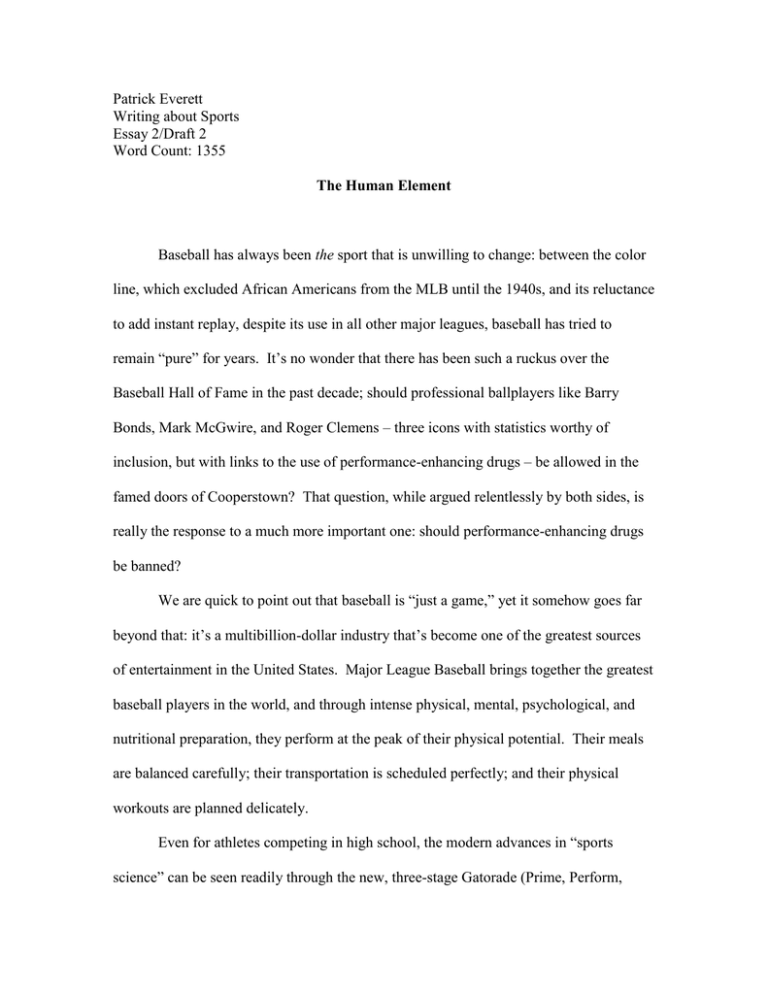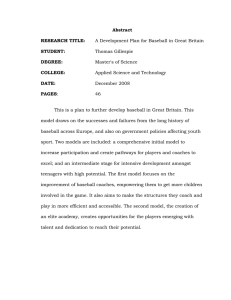Patrick Everett Writing about Sports Essay 2/Draft 2 Word Count: 1355
advertisement

Patrick Everett Writing about Sports Essay 2/Draft 2 Word Count: 1355 The Human Element Baseball has always been the sport that is unwilling to change: between the color line, which excluded African Americans from the MLB until the 1940s, and its reluctance to add instant replay, despite its use in all other major leagues, baseball has tried to remain “pure” for years. It’s no wonder that there has been such a ruckus over the Baseball Hall of Fame in the past decade; should professional ballplayers like Barry Bonds, Mark McGwire, and Roger Clemens – three icons with statistics worthy of inclusion, but with links to the use of performance-enhancing drugs – be allowed in the famed doors of Cooperstown? That question, while argued relentlessly by both sides, is really the response to a much more important one: should performance-enhancing drugs be banned? We are quick to point out that baseball is “just a game,” yet it somehow goes far beyond that: it’s a multibillion-dollar industry that’s become one of the greatest sources of entertainment in the United States. Major League Baseball brings together the greatest baseball players in the world, and through intense physical, mental, psychological, and nutritional preparation, they perform at the peak of their physical potential. Their meals are balanced carefully; their transportation is scheduled perfectly; and their physical workouts are planned delicately. Even for athletes competing in high school, the modern advances in “sports science” can be seen readily through the new, three-stage Gatorade (Prime, Perform, Recover) or the easily accessible protein powder for workout recovery. These all enhance athletic performance – that’s their exact purpose – but yet they’re not PEDs. We’ve pushed athletes to be the fastest, strongest, and smartest they can be, but we still have an arbitrary line of drinks, pills, and creams that are banned; why not get rid of the line and just see what we really want to see? In Lewis Lapham’s “Mudville,” he asks the same question. His satirical essay describes the American way of life as “a ceaseless effort to boost performance, hype the message, enhance the product,” drawing on examples of plastic surgery and ADHD medicines to point out that Americans always tend to be pushing the old-school limits through new technologies – not a good thing in Lapham’s opinion. He uses the example of a young baseball player who knows if “he can hit another fifteen or twenty home runs…his pay will rise to $1 million” to shed light on why athletes would be willing to break the rules and use illegal substances. The Mitchell Report, a document describing the sad state of the performance-enhancing drugs in the MLB, uses the more conventional arguments against PEDs, noting that “the players who follow the law and the rules are faced with the painful choice of either being placed at a competitive disadvantage or becoming illegal users themselves. No one should have to make that choice.” Two common arguments opposing any steroid use in sports are the advantage it gives some players and the health risks associated with steroids. There are the stories of cheaters who juice and become superstars while the “clean” athlete falls behind. Yet opening the world of sports up to any substance under the Sun would eliminate this competitive advantage that the Mitchell Report mentions. And then there are the heavily publicized health risks of abusing anabolic steroids. But with the toll that playing 2 professional sports at the highest level takes on players’ bodies, and even after their careers end (like a running back’s aching knees or a pitcher’s sore shoulder or a linebacker’s brain issues decades after his final game), it is apparent that the health of professional athletes isn’t the top priority. Major League Baseball saw exciting home-run records, faster pitches than ever before, and the highest revenue in League history during the past decade. However, the tainted reputation that follows the game’s biggest stars limited the success of the League. It seems obvious that the best way to keep these positives (exciting on-field performances) while removing the negatives (endless scandals and suspensions) would be to remove the restrictions and allow PEDs. But what would that game look like a few years from now? Decades from now? Would it still be “baseball”? The draw to professional sports is that these athletes are all human beings. If we examined the DNA of Alex Rodriguez or Miguel Cabrera or Clayton Kershaw, it wouldn’t be all that different from our very own DNA. We see the beauty and gravity-defying athleticism of these stars, but we only can truly appreciate them because they’re humans, just like us. The human element is already a controversial topic in sports with the use of instant replay. Although these systems are accurate enough to be shown real-time during TV broadcasts, MLB prefers to live and die with the decisions of umpires on strikes and balls instead of using a system of cameras and computers to decide where a pitch passed the batter. And even with the flawless replay system in tennis (to tell if the ball landed in play or out of play), referees still make the vast majority of decisions during a match. There’s an essential component of sports that comes from humans making plays and 3 humans making decisions. When athletes are suddenly allowed to inject anabolic steroids and human growth hormone instead of just drinking an over-the-counter protein shake following a workout, the human factor starts to disappear. And after years of medical and technological advances, the game would change completely. Lapham describes this frightening future where a juiced hitter would see a ball that “looks as big as a grapefruit” and “infielders rigged with silicon circuits in their heads turn double plays at broadband speed.” Sports have certainly evolved over the years through modern equipment and minor rule changes, but they are recognizable at all points in time because they always have one constant: humans. The idea that allowing any substances for any athlete would “level the playing field” and remove the competitive advantage is sadly not the case. Just as some teams (the Yankees, the Heat, the Cowboys) are willing to spend money to attain top-of-the-line players and facilities, they would also be able to hire the best doctors and chemists to create the absolute best supplements. But even more than that, not all athletes react the same way to certain drugs. The article “A Massive Fraud Now More Fully Exposed” by Alex Wolff and David Epstein describes the lies of Lance Armstrong in reference to his doping and work to cover his back. It mentions one of Armstrong’s teammates, Stephen Swart, who took EPO (a common drug in cycling) and it “straightaway…made [him] perform worse.” As Wolff and Epstein note, some cyclists are able to receive bigger boosts when taking EPO because of the way the rules are set up (there was no test for EPO, so they set a limit on the amount of red blood cells during blood tests). Just as some athletes respond better to weight lifting while others prefer cardio, or some athletes 4 need an extra day of rest before the playoffs while others need “tune-up” games, they would react differently to this world of drugs. It’s true that baseball, football, cycling, and track have had a difficult time adjusting to the world of performance-enhancing drugs. Baseball’s record book is now dotted with asterisks, the podiums from the Tours de France of the early 2000s were crowned by cheaters, and one of the most decorated sprinters of the 2000 Sydney Games, Marion Jones, faced jail time stemming from her doping. But the answer to these problems isn’t to change the rules completely; we as fans want to see the best “product” on the field, but only up to a point. We don’t watch video-game simulations for entertainment; we watch human beings. Professional sports are loved because the competitors are people just like us moving in ways we could never imagine ourselves doing. The beauty of sports comes from the human athletes, and every time we say that some new magical pill or medicine is allowed, the human element grows ever smaller. 5 MIT OpenCourseWare http://ocw.mit.edu 21W.015 Writing and Rhetoric: Writing about Sports Fall 2013 For information about citing these materials or our Terms of Use, visit: http://ocw.mit.edu/terms.



